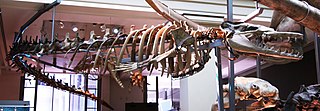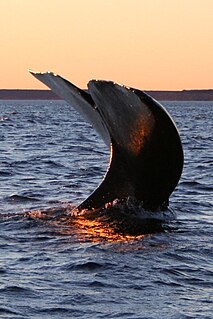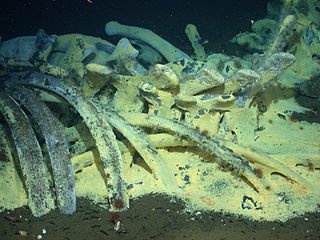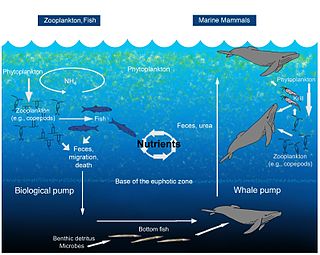 W
WWhales are a widely distributed and diverse group of fully aquatic placental marine mammals. They are an informal grouping within the infraorder Cetacea, usually excluding dolphins and porpoises. Whales, dolphins and porpoises belong to the order Cetartiodactyla, which consists of even-toed ungulates. Their closest living relatives are the hippopotamuses, having diverged about 40 million years ago. The two parvorders of whales, baleen whales (Mysticeti) and toothed whales (Odontoceti), are thought to have split apart around 34 million years ago. Whales consist of eight extant families: Balaenopteridae, Balaenidae, Cetotheriidae, Eschrichtiidae, Monodontidae, Physeteridae, Kogiidae, and Ziphiidae.
 W
WBasilosaurus is a genus of large, predatory, prehistoric archaeocete whale from the late Eocene, approximately 41.3 to 33.9 million years ago (mya). First described in 1834, it was the first archaeocete and prehistoric whale known to science. The first fossils were discovered along the Gulf Coast of the United States, along with a few fossils in the eastern U.S., attributed to the type species B. cetoides. They were originally thought to be of a giant reptile, hence the suffix "-saurus", Ancient Greek for "lizard". The animal was later found to be an early marine mammal, which prompted attempts at renaming the creature, which failed as zoological nomenclature dictates using the original name given. Fossils were later found of the second species, B. isis, in 1904 in North Africa, more specifically the countries of Egypt, Jordan, Tunisia and Morocco. Basilosaurus has a possible record in Seymour Island in Antarctica.
 W
WCetacean stranding, commonly known as beaching, is a phenomenon in which whales and dolphins strand themselves on land, usually on a beach. Beached whales often die due to dehydration, collapsing under their own weight, or drowning when high tide covers the blowhole. Cetacean stranding has occurred since before recorded history.
 W
WBubble-net feeding is a unique and complex feeding behavior engaged in by humpback whales and Bryde's whales. It is one of the few surface feeding behaviors that humpback whales are known to engage in. This type of feeding is often done in groups. The group size can range from a minimum of two or three whales participating and up to sixty at one time. Whales can also perform a similar method of surface feeding called lunge feeding but this is done solo.
 W
WCetacean strandings in Ghana appear to be becoming more common. Whales washing ashore may be due to ship strike, population dynamics, or an increase in human coverage and reporting. There are at least 28 species of cetaceans — seven baleen whales and 21 toothed whales — in the Gulf of Guinea, of which Ghana’s coast covers 550 km from Aflao to Axim. Scientific approaches to cetacean diversities have not been taken until recently, and 18 species were confirmed during researches.
 W
WA drift whale is a cetacean mammal that has died at sea and floated into shore. This is in contrast to a beached or stranded whale, which reaches land alive and may die there or regain safety in the ocean. Most cetaceans that die, from natural causes or predators, do not wind up on land; most die far offshore and sink deep to become novel ecological zones known as whale fall. Some species that wash ashore are scientifically dolphins, i.e. members of the family Delphinidae, but for ease of use, this article treats them all as "drift whales". For example, one species notorious for mass strandings is the pilot whale, also known as "blackfish", which is taxonomically a dolphin.
 W
WThere have been several cases of whale carcasses bursting due to a buildup of gas in the decomposition process. Actual explosives have also been used to assist in disposing of whale carcasses, ordinarily after towing the carcass out to sea. A widely reported case of an exploding whale occurred in Florence, Oregon, in November 1970, when the Oregon Highway Division blew up a decaying sperm whale with dynamite in an attempt to dispose of its rotting carcass. The explosion threw whale flesh over 800 feet away. American humorist Dave Barry wrote about it in his newspaper column in 1990 after viewing television footage of the explosion, and later the same footage circulated on the Internet. It was also parodied in the 2007 movie Reno 911!: Miami and in the 2018 Australian comedy Swinging Safari.
 W
WIn marine biology, a flukeprint is a patch of calm water on the surface of the ocean, formed by the passing of a whale. Flukeprints may also be named by the word for them in the Inupiaq language, qala.
 W
WMessapicetus is an extinct genus of beaked whale from the Late Miocene. It currently holds two species, M. longirostris from the Tortonian of Italy and M. gregarius from the Pisco Formation of Peru. However, a third unnamed species is represented in the St. Marys Formation of Maryland known from fragmentary material. M. gregarius is sexually dimorphic, males having tusks which are hypothesized to have been used in intraspecific combat for mates as in extant (living) beaked whales.
 W
WTail sailing refers to the action of whales lifting their tails clear of the water for long periods of time. The process is rarely observed by humans, and the precise motivation for this phenomenon is unknown. It is thought that whales either undertake this activity to catch the wind and 'sail' through the water, or as a method to cool down. A third theory suggests that the whale is feeding close to the sea floor.
 W
WA whale fall occurs when the carcass of a whale has fallen onto the ocean floor at a depth greater than 1,000 m (3,300 ft), in the bathyal or abyssal zones. On the sea floor, these carcasses can create complex localized ecosystems that supply sustenance to deep-sea organisms for decades. This is unlike in shallower waters, where a whale carcass will be consumed by scavengers over a relatively short period of time. Whale falls were first observed in the late 1970s with the development of deep-sea robotic exploration. Since then, several natural and experimental whale falls have been monitored through the use of observations from submersibles and remotely operated underwater vehicles (ROVs) in order to understand patterns of ecological succession on the deep seafloor.
 W
WWhale feces, the excrement of whales, has a significant role in the ecology of the oceans, and whales have been referred to as "marine ecosystem engineers". Nitrogen released by cetacean species and iron chelate is a significant benefit to the marine food chain in addition to sequestering carbon for long periods. Whale feces can give information on a number of aspects of the health, natural history and ecology of an animal or group as it contains DNA, hormones, toxins and other chemicals.
 W
WCetacean surfacing behaviour or breaching is a group of behaviours demonstrated by the Cetacea infraorder when they come to the water's surface to breathe. Time intervals between surfacing can vary depending on the species, surfacing style or the purpose of the dive, and some species have been known to dive for up to 85 minutes at a time when hunting. In addition to respiration, cetaceans have developed and used surface behaviours for many other functions such as display, feeding and communication. All regularly observed members of the order Cetacea, including whales, dolphins and porpoises, show a range of surfacing behaviours. Cetacea is usually split into two suborders, Odontoceti and Mysticeti, based on the presence of teeth or baleen plates in adults respectively. However, when considering behaviour, Cetacea can be split into whales and dolphins and porpoises as many behaviours are correlated with size. Although some behaviours such as spyhopping, logging and lobtailing occur in both groups, others such as bow riding or peduncle throws are exclusive to one or the other. It is these energetic behaviours that humans observe most frequently, which has resulted in a large amount of scientific literature on the subject and a popular tourism industry.